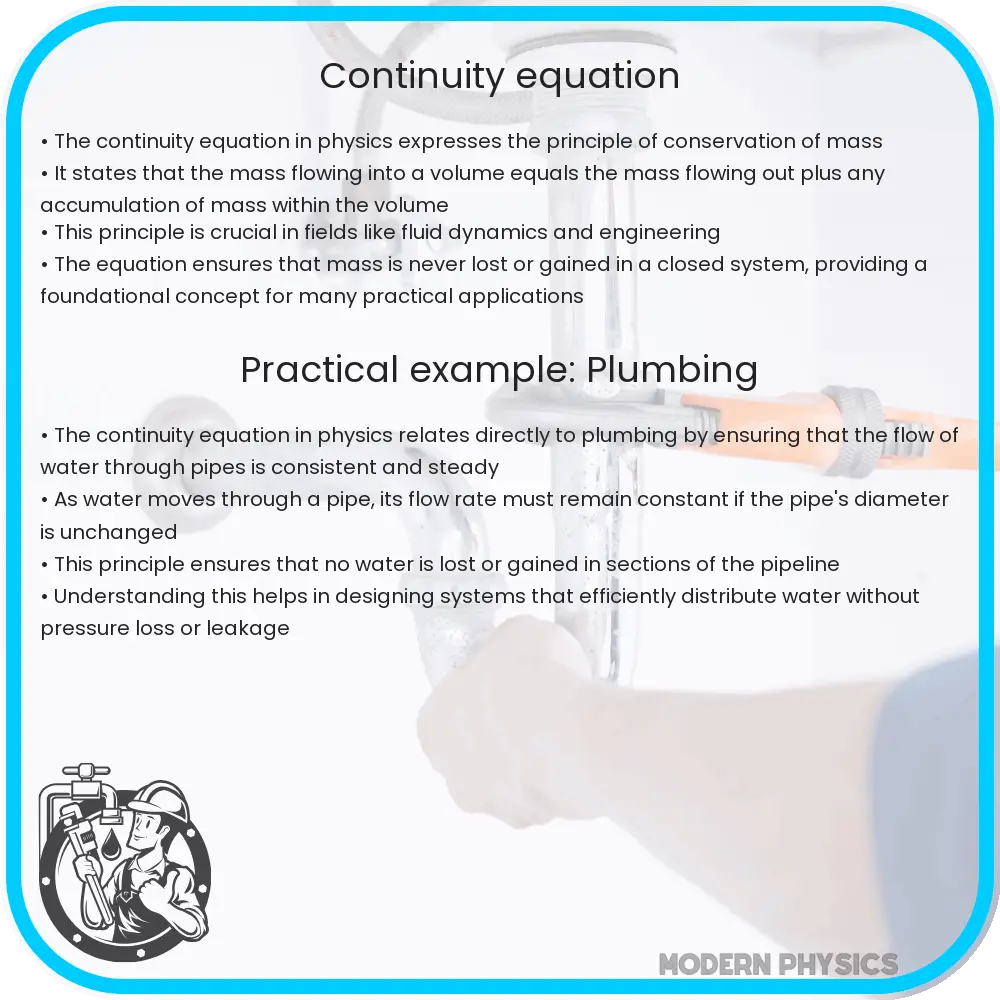Explore the essentials of the Continuity Equation in fluid dynamics, covering its applications in engineering, environmental science, and physics.

Understanding the Continuity Equation in Fluid Flow
The continuity equation is a fundamental concept in fluid dynamics, playing a crucial role in the study of fluid flow and its behaviors. This equation is a mathematical representation of the principle of conservation of mass in a fluid system. It asserts that the mass of fluid entering a system must equal the mass leaving the system, assuming the system is in a steady state and the fluid is incompressible. This principle is crucial in various applications ranging from engineering to environmental studies.
Basics of the Continuity Equation
The general form of the continuity equation can be expressed as:
\[ \frac{\partial \rho}{\partial t} + \nabla \cdot (\rho \vec{v}) = 0 \]
where:
- \(\rho\): Fluid density
- \(t\): Time
- \(\vec{v}\): Velocity vector of the fluid
- \(\nabla \cdot (\rho \vec{v})\): Divergence of the mass flux
In simpler terms, this equation states that the rate of change of mass in a fluid element is equal to the divergence of the mass flux. For an incompressible fluid where the density \(\rho\) is constant, the equation simplifies to:
\[ \nabla \cdot \vec{v} = 0 \]
Applications in Fluid Flow
The continuity equation is vital in understanding fluid dynamics in various contexts. In pipe flow, for instance, the equation helps in determining the velocity of fluid in pipes of varying diameters. This has practical implications in designing piping systems for industries and urban water supply. Similarly, in aerodynamics, the continuity equation assists in understanding airflow over aircraft wings, contributing to the design of more efficient airfoils.
Conservation of Mass and Fluid Dynamics
The principle of conservation of mass underpins the continuity equation. This principle posits that mass cannot be created or destroyed within a closed system. In the context of fluid flow, it translates to the understanding that the mass flow rate of a fluid remains constant along a streamline. This understanding is crucial in analyzing fluid flow in both open channels and closed conduits.
Overall, the continuity equation serves as a cornerstone in the study of fluid mechanics, offering insights into the behavior of fluids under various conditions. Its applications are vast, ranging from industrial processes to natural phenomena like river flows and atmospheric circulation.
Continuity Equation in Complex Fluid Systems
When dealing with complex fluid systems, the continuity equation adapts to account for various factors such as changes in fluid density and flow patterns. In compressible flows, where the density of the fluid changes significantly, the full form of the continuity equation must be used. This is particularly relevant in high-speed aerodynamics, where air density varies with altitude and speed.
Mathematical Formulation in Three Dimensions
In three-dimensional fluid flow, the continuity equation takes a more detailed form, accounting for fluid movement in all directions. The equation can be represented as:
\[ \frac{\partial \rho}{\partial t} + \frac{\partial}{\partial x}(\rho v_x) + \frac{\partial}{\partial y}(\rho v_y) + \frac{\partial}{\partial z}(\rho v_z) = 0 \]
where \(v_x\), \(v_y\), and \(v_z\) are the components of the velocity vector in the x, y, and z directions, respectively. This formulation is crucial in complex simulations and analyses, such as weather prediction and the design of sophisticated fluid machinery.
Role in Environmental and Geophysical Studies
The continuity equation is not just limited to engineering and physics but also extends to environmental science and geophysics. It helps in modeling the movement of water in rivers and estuaries, the flow of air in the atmosphere, and even the movement of glaciers. Understanding fluid flow through the continuity equation is essential in predicting environmental changes and developing sustainable practices.
Conclusion
The continuity equation is a fundamental principle in fluid mechanics, underpinning the study of fluid dynamics in various disciplines. From its basic form in incompressible flows to its more complex expressions in compressible and three-dimensional flows, this equation provides a critical framework for understanding and predicting fluid behavior. Its application extends beyond traditional engineering and physics, playing a significant role in environmental science, geophysics, and even meteorology. By encapsulating the principle of mass conservation, the continuity equation offers invaluable insights into the natural and man-made fluid systems, aiding in the advancement of technology and the protection of our environment.
